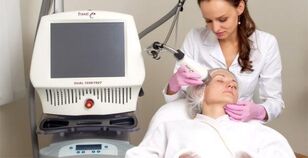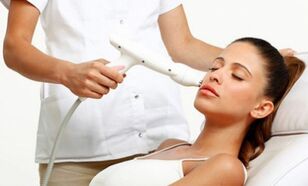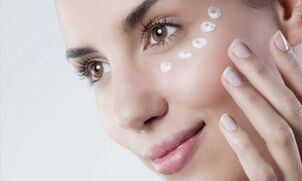Aging is a natural biological process that affects all tissues of the human body, including those that make up a person's appearance. At the same time, facial tissues are more sensitive to aging than others because they are constantly under the influence of environmental factors, chewing, imitation and speech functions. Since the face is a kind of "business card" of a person, the issue of preserving and restoring the youth of the facial skin is particularly important and relevant. Among the many methods and techniques used to solve this problem today, laser facial rejuvenation deserves special attention.
The essence of this method is the fractional effect of a laser beam on the skin. The laser flow is divided into many thinnest beams that are at a precisely defined depth that affect the microscopic areas of the skin and evaporate them. Among these areas, intact cells stimulate the production of active collagen and elastin, the two main "building materials" in the human body that are less and less formed with age. After this procedure, the skin color improves, fine and medium wrinkles are corrected, under-eye bags are removed and the face contour is tightened. At the same time, the rehabilitation period is minimized. Fractional laser rejuvenation can be used not only as an independent method, but also to improve the results of plastic surgery or laser resurfacing.

Lasers used for fractional laser rejuvenation
For the first time in the world, a patent for the fractional laser exposure principle was obtained in 2004 by the American company Palomar Medical Technologies. Fractional laser systems are currently represented by various laser technology companies. The most common are laser systems from Palomar and Fraxel, Affirm laser from the famous American company Cynosure, GentleYAG laser from Candela, and others. Since all these attitudes have a common principle of action, the outcome of the procedure is largely determined by the professionalism of the expert performing the procedure.
Contraindications of the laser rejuvenation procedure
Absolute contraindications to the procedure are:
- Pregnancy, breastfeeding.
- Foci of the inflammatory process in the affected area.
- Psoriasis and dermatoses.
- Herpes infection foci in the affected area.
- Chemical peeling of the intended treatment site was performed less than two weeks before the procedure.
- Oncological diseases.
- Systemic diseases of blood, immune system, connective tissue.
- Diabetes mellitus in the decompensation stage.
- Severe hypertension and types of coronary heart disease.
- Varicose veins in the process area.
- Tendency to form keloid scars.
- Family history of vitiligo.
Relative contraindications include active sun exposure within the last three weeks prior to the procedure, i. e. the presence of fresh sunburn, and superficial and midline peeling done on the treatment area less than three weeks before the procedure.
Benefits of Fractional Laser Rejuvenation
Thanks to the point effect, skin damage is minimal as all scars disappear within 3-4 days after the procedure.
Themethod allows you to treat large areas of the skin with a single procedure, while maintaining and activating the regenerative source of the skin, which ensures rapid rehabilitation and long-term growth of positive effect.
The procedure does not require anesthesia, it can be performed on the neck, décolleté and around the eyes.
Side effects are rare. Possible complications include temporary appearance of red-purple spots at the treatment site, mild and rapidly resolving itching, activation of herpes infection, burns, changes in skin texture, including peeling and crusting. Scars, hyper and hypopigmentation of the skin at the procedure site are extremely rare, but may be permanent.
What is the full program of laser rejuvenation procedures
One session of fractional laser exposure takes 20-40 minutes, depending on the nature of the problem and the area of the treated area. Repeated procedures are carried out within 3-4 weeks. As a rule, a total of 3-4 sessions are required. The maximum positive effect occurs within three months after the last procedure. Maintenance sessions are recommended every 10-14 months.

What to do after laser facial rejuvenation
While the slight burning sensation that can be felt after the procedure disappears within 1-2 hours, redness and mild swelling may continue for 1-3 days. During this period, external agents (creams, ointments, sprays) containing dexpanthenol should be used, for example, Bepanten, Panthenol, D-Panthenol. A cream containing hyaluronic acid is applied after the disappearance of the listed symptoms and before the next procedure.
You can shower and wash on the day of the procedure, but it is better to wait in the sauna and pool. Foundation can be used one day after the procedure.
It is imperative to use sunscreens with a protection factor of at least 30, because during this time the skin's metabolism is activated and becomes particularly sensitive to sunlight.
After the process, it is necessary to follow the advice of the expert who performed the transaction. The selection, frequency and duration of cosmetic products are determined individually and depend on the skin type and characteristics.
Fractional laser rejuvenation is a cosmetic procedure in which the skin is exposed to a laser array consisting of micro rays. The purpose of this effect is to activate regeneration processes and collagenogenesis. This is a relatively new, but already very popular hardware technique. In another way, fraxel is called fractional laser resurfacing or photothermolysis.
Working principle and types of fractional laser rejuvenation
How does a fractional laser work? The micro rays emitted by the apparatus cause a heat shock as the "lazy" skin cells begin to function more actively. They split faster to repair the damaged area. Old cells that do not work die and are replaced by young people. The warming of the deep layers of the skin is accompanied by the partial denaturation of proteins, as well as the formation of new components of the extracellular matrix, including elastin and collagen.
Ablative and non-ablative laser rejuvenation are distinguished according to the pulse depth. The first is superficial and similar to grinding. Laser treatment of the upper layers of the skin is accompanied by the evaporation of moisture, damage to the epidermis. After it has healed, the skin is more toned, relaxed and flattened. During non-ablative photothermolysis, the laser affects the deep layers of the skin. In this case, there is no open wound.
Each type of rejuvenation has its advantages and minutes. Therefore, the effect of ablative laser resurfacing is noticeable after the first procedure. With this method, you can get rid of deep wrinkles and age spots, acne, cracks, scars. With a non-ablative procedure, there is no risk of infection, and the anti-aging effect is noticeable for several years. This type of photothermolysis is recommended for people under 40 with the first signs of aging: fine wrinkles, reduced turgor.
Indications and contraindications for the procedure
Worth referring if photothermolysis procedure is available:
- Loose, sagging skin.
- Both fine and deep wrinkles, crow's feet.
- Pigmentation from any source.
- Increased sebum secretion.
- Enlarged pores prone to acne.
- After scars, stretch marks, acne.
- Vascular "stars" (rosacea).
- Dull skin color.
Contraindications for fractional laser rejuvenation are:
- Allergy, psoriasis.
- Autoimmune diseases.
- Pregnancy, breastfeeding.
- Blood diseases.
- Skin infections, inflammations in the intended treatment area.
- Any chronic disease in the decompensation stage.
- Oncology.
- Increased body temperature.
- Diabetes mellitus.
- Tendency to form keloid scars.
- Epilepsy.
Features of laser rejuvenation
Preparation for the fractional photothermolysis procedure consists of refusing to visit the solarium and beach for two weeks. All this time, you cannot clean your skin, do chemical peels, take sulfonamides, fluoroquinolones, tetracyclines. Three days before the procedure, they stop going to the pool, bath, sauna, and treat the allegedly exposed area with alcohol-containing cosmetics. To avoid complications, the cosmetologist may prescribe antiviral and antibacterial drugs for this period. The day before the procedure should be spent without alcohol and smoking and avoiding going to the gym.
Before laser treatment, the skin is cleared of cosmetics and dirt. Generally, the laser effect feels like an uncomfortable tingling sensation, but sometimes pain relief may be required. In this case, the beautician applies anesthesia to the prepared skin area. After the ointment works, it continues to treat the skin with laser. The duration of the procedure depends on the size of the treatment area and varies from a few minutes to an hour. Finally, the skin is soothed with a nourishing cream.
In the first days after the procedure, you should not use alcohol-based products and do not compress the body parts with photothermolysis with compression cloth. For a week, it is recommended to exclude physical activity, visit the pool, sauna or bath, limit time spent on the street. The skin is moistened with a special cream three times a day. And so for half a month. It is undesirable to peel, use cosmetics with retinol, salicylic acid. It is necessary to use a cream with a sun protection factor of 35 or more for two months.
How many procedures do you need to get the result? What effect can you expect?
The rehabilitation period after laser fractional rejuvenation lasts 3 to 7 days. The speed of recovery is very dependent on lifestyle. Alcohol consumption, smoking, excessive activity, malnutrition, insomnia and anxiety - all of these can slow the regeneration process.
In the first three days after laser exposure, there may be redness and slight swelling on the skin. Anesthetics and cooling of the skin can help reduce the discomfort. It is normal to feel tightness on the skin within a week, there are scaly areas. A side effect of the procedure may be a bronze tan that disappears on its own after half a month.
A permanent result after fractional photothermolysis occurs after 2-5 procedures. More specifically, the number of sessions can only be determined by a beautician based on preliminary data. The intervals between procedures are 3-4 weeks. As a result of fractional laser rejuvenation, aging processes are inhibited: wrinkles disappear or become less noticeable, turgor increases, the intensity of the pores decreases, and the skin improves. This method is an effective tool in combating scars, pigmentation, post-acne, stretch marks.
Laser fractional rejuvenation is one of the three most popular enhancement cosmetic procedures. Its advantages include efficiency, short recovery time, physiology. The result is visible after the first procedure and lasts up to three years. The method has a wide range of indications. It is possible to choose the depth of laser exposure.
A woman of all ages wants to see beautiful skin in the mirror, but not everyone is ready to go under a plastic surgeon's knife.
In this case, fractional rejuvenation will come to the rescue with the use of a laser that takes one of the first places in modern cosmetology procedures to delay aging.
Types and methods of exposure
Ablative photothermolysis
There are two methods of photothermolysis, each suitable for different situations. The right choice in favor of the best option will help the beautician make the first appointment.
This method is suitable for rejuvenating naturally aging skin.
Laser-assisted micro damage network affects only the upper layers of the epidermis and forces it to regenerate in a short time.
The result is visible after the first procedure, as soon as the wounds heal.
Non-ablative photothermolysis
This method is a bit more serious intervention. The laser beam penetrates the deep layers of the epidermis, ignoring the outside cells.
Damage also increases elastin and collagen production as in ablative photothermolysis.
The healing process takes longer and the effect is more noticeable. It is suitable for solving serious facial problems.
Readings
Anyone who wants to rejuvenate without serious braces can use this method.
Fractional laser therapy combats many facial imperfections:
severe wrinkles on the forehead- ;
- nasolabial folds;
- crow's feet thread around the eyes;
- epidermis "flowing" down;
- skin pigmentation, scars, scars, spider veins;
- enlarged pores, acne problem.
Laser treatment has been shown to be very effective in eliminating all these problems.
The only caveat is that several procedures may be required depending on the severity of the defect.
Contraindications
Like any other external influence on the body, fractional laser rejuvenation has its own contraindications for which it is prohibited to resort to such a procedure.
This includes:
- the presence of severe inflammation on the face;
- infectious, fungal skin lesions;
- epidermis diseases - psoriasis, eczema;
- excessive dryness of the skin;
- malignant neoplasms in the body;
- epilepsy history;
- heart disease; percent
- varicose veins;
- herpes in the acute stage;
- pregnancy, breastfeeding;
- immunodeficiency states;
- bronchial asthma, severe allergic reactions;
- neurological diseases.
All contraindications are conditional, ie the cosmetologist weighs all the risks of the patient.
Sometimes you first need to seek treatment for skin problems or wait for chronic diseases to be alleviated, then rejuvenation still continues.
Preparation
No serious preparation is required as the intervention is not a surgical operation. Initially, you should consult a beautician who will assess the condition of the skin and also give advice on the required method of photorejuvenation.
The patient has to tell his doctor about all past conditions and diseases as well as exacerbations of chronic diseases in the past six months.
If available, the specialist will recommend that you visit specialist doctors to assess the safety of the procedure.
To identify or exclude inflammatory processes in the body, you should also perform a blood and urine test. The date of the first visit is set later.
Execution
Skin rejuvenation with fractional laser in the face area is performed in the outpatient clinic, so the patient enters, is treated, then goes home.

The beautician will first apply lidocaine-based anesthetic cream or ointment to the epidermis.
In fact, the procedure is not extremely painful, so sometimes therapy is performed without going through this phase.
Note that the use oflocal anesthetic somewhat inhibits the natural regeneration of the skin later.
The patient then lies on the chair and the specialist sets the penetration depth of the laser beam using a special device. The device is intended for specific areas of the epidermis where the laser penetrates deeply.
Manipulations take half an hour or more depending on the area to be treated with the device. During the procedure, the patient may feel a slight tingling sensation as well as an unpleasant odor.
Immediately after the session, a grid with red dots appears on the face, the skin is red, slightly swollen, so it is better to pay attention to the way home in advance.
Possible complications
Fractional rejuvenation does not rule out complications. In some cases it is normal and will disappear within a few days.
Others develop due to the inexperience of the beautician or the lack of proper facial care during the rehabilitation period.
What is non-norm:
- severe pain or swelling at the laser beam exposure site;
- lesions do not heal within two weeks;
- pigmentation and scars appeared.
Mild redness, scaling, and itching is a predictable condition for all types of epidermis.
Such results spontaneously disappear within 1-2 weeks without leaving any visual defects.
Rehabilitation
The result of the operation is greatly affected by the behavior of the patient himself. One should carefully monitor the skin, protect it from aggressive environmental influences and not apply decorative cosmetics during healing.

General directives:
- The first three days of the wound should be lubricated with a dexpanthenol-based ointment, will allow micro damage to heal quickly. Then it is recommended to use a mild moisturizer with hyaluronic acid recommended by the beautician.
- Washing is not prohibited.The epidermis should not be exposed to strong heat for 2 weeks, so it is better to avoid baths and saunas and not take hot baths.
- You should not go out without sunscreen,and it is better to choose more than 50 protection. If this is not done, hyperpigmentation will occur. The cosmetic product should be applied until full recovery even if it is winter outside.
It is recommended to visit the specialist performing fractional laser rejuvenation again after a few weeks. It should assess the condition of the skin on the face, exclude complications.
Prediction
If the defects are not obvious, the result can be seen immediately after recovery. Deep wrinkles or scars should be removed with a few treatments.
Visually, the skin is smoother, has a natural color, the face is tightened and noticeably blooms in 99% of cases.
One percent is dedicated to unforeseen conditions, inadequate care and lack of qualifications of the doctor.
Advantages of the method
For many patients, this method wins with significant advantages. By choosing photothermolysis, a person gets:
- low cost with high efficiency;
- painlessness;
- effect even in one procedure;
- non-invasive;
- no strong side effects.
In addition, the effect of laser solves many problems of the aesthetic component of the epidermis simultaneously, which is good news.
Disadvantages
If you choose the wrong clinic for rejuvenation or do not strictly follow the beautician's advice, you may gain large age spots on half of the face that will not be easy to remove.
Also, laser treatment takes quite a long time, and during this time the patient feels an unpleasant odor of damaged skin that not everyone can tolerate.
Another disadvantage is the incomplete result from a procedure that includes deep dents, scars, and wrinkles.
Examination of opinions
Fractional rejuvenation is gaining popularity in cosmetics. More and more women are choosing laser over surgical scalpel every year.















































































